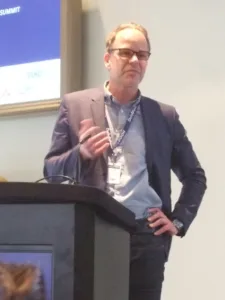Neil Morris, CEO of Grand Visual, gave what many people I talked to named as the most interesting talk of the day. Grand Visual is a production company that is 10 years old this year; its first-ever content was a video of Rocky Balboa running up the digital escalator panels (DEPs) in the Tottenham Court Road Underground station. This creation was launched on 1st January 2006, and Morris travelled into London at 6am to see it. “I forgot to account for the hordes of drunk people and vomit”, he recalled, “but it was still great to see”.
Grand Visual has participated in some very striking DOOH and OOH projects, such as a shadow wall where peoples’ shadows were replaced with those of Disney characters, and an LED display where passers-by were followed by a ‘thought bubble’ showing a Big Mac.
Because Grand Visual is 10 this year, Morris came up with 10 observations about the industry:
1. There has been a certain amount of categorisation around campaigns, which means that we have some common language amongst industry members. Chiefly these are types of content: ‘linear’, playing out in a loop; ‘dynamic’, which is affected or triggered by an external event such as the weather; and ‘interactive’. A graph illustrated that linear’s revenue share at Grand Visual is falling while dynamic and interactive content are climbing. Morris assured us that the overall revenue of all three is still on the rise, though,
2. Infrastructure versus people. The move to digital requires thought and investment in talent; Grand Visual now employs more software developers than graphic artists/animators.
3. Scalable campaigns are created today to serve international clients. These can be rolled out to multiple markets more easily.
4. America is different! A fact unappreciated by many local brands is that the American market is quite conservative compared to the UK. Grand Visual has operated in New York for 12 months and Morris has noticed a lack of dynamic and interactive campaigns.
5. Smarter creative. This point was obviously close to Morris’ heart, as he talked about it a lot! The argument was that dynamic content should be seen as ‘normal’ rather than innovative. There is a huge amount of data available today that can make campaigns smarter and more relevant. To demonstrate this, Morris showed data claiming that 61% of marketers want real-time information in their campaigns, but only 5% of campaigns use it. These types of campaigns, though, work well and are repeatable. For example, a Benadryl ‘pollen tracker’ campaign has been run every spring for the last three years.
6. Creative agencies are huge influencers, but they can sometimes struggle to keep pace with real-time campaigns – the industry must make it easier for them.
7. Reporting is inevitable (harking back to Big Data), but we’re not very good at it. We want lots of data, which means that there are a lot of permutations for any smart campaign – but the data need to be visible. Morris gave an excellent example of the Missing People campaign, which places photographs of and information about missing people on screens in the local area. The challenges here are that the entire campaign is based around the availability of media; is driven by data from a third party (the police); and is hugely time-sensitive.
The client behind the Missing People campaign needed to know what content is live where – it would be useless to have pictures of someone who went missing in the north-west of England showing up in the south-east! It is possible to know what was published, but not what is playing live at any one time. Grand Visual has this technology, but only two of the ten media owners involved in the project have agreed to use it.
8. Properly-integrated campaigns are important. DOOH is a big, rich and versatile landscape.
9. Media owners are always wrong! A controversial statement considering the audience, but Morris added that we don’t want to be here – the aim is ‘one dream, one team’.
10. The medium is in good hands. Perhaps making up for his previous point, Morris said that the DOOH sector is doing its best to move forward. There are young people entering the industry with new ideas: a whole generation of people who have grown up with DOOH. Of course, he went and put his foot in it again with his following statement: “There are dinosaurs out there, but they are moving on and they will die”!
In a short Q&A, Morris said that Grand Visual will launch a new DOOH software suite this year.

